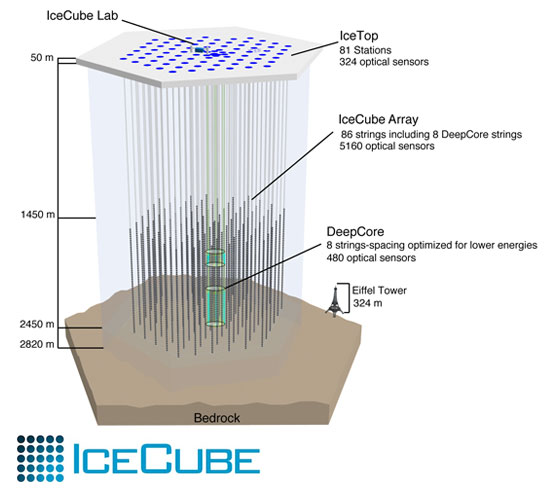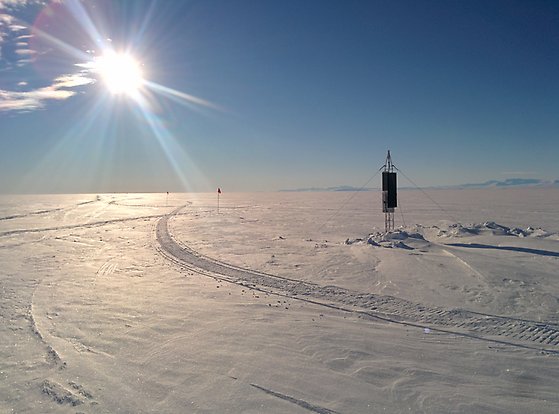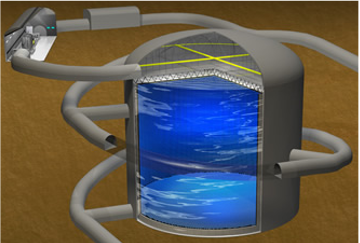Astroparticle Physics

Astroparticle physics (sometimes called particle astrophysics) is an emergent field of research on the border between particle physics, astrophysics and cosmology. The theoretical branch of this field explores issues relating to the evolution of the cosmos, gravity, dark matter and dark energy, connecting the domain of particle physics with astrophysics and cosmology.
The experimental programs develop frontline detectors and study various forms of “messengers” reaching us from the outer space – cosmic rays, gamma rays, gravitational waves and neutrinos – to address questions relating to the origin of the ultra-high energy cosmic rays, the processes driving the energy output of some of the most luminous objects in the Universe (e.g. the vicinity of a super-massive black hole (active galactic nuclei), neutron star mergers, gamma ray bursts or super nova explosions), the nature of dark matter, the fundamental properties of neutrinos and aspects of physics beyond the Standard Model, among others. Multi-messenger astronomy is a relatively new development where (simultaneous) information from several types of messengers is correlated to gain additional insights.
The experimental astroparticle group at Uppsala University has a longstanding interest in neutrinos. We have participated in the design and construction of the IceCube Neutrino Observatory at the South Pole, and are members of the international IceCube collaboration responsible for the scientific research with this detector. We are also involved in the Hyper-Kamiokande project to develop and deploy the next-generation large ultra-pure water Cherenkov neutrino detector in Japan. We are developing instrumentation and methods for radio-detection of ultra-high energy neutrinos, and members of the ARIANNA, RNO-G and IceCube-Gen2 collaborations. And – we have interest in the PTOLEMY experiment aiming to observe the cosmic 1.95 K neutrino background.
The IceCube Neutrino Observatory
IceCube is a particle detector at the South Pole that records the interactions of a nearly massless sub-atomic particle called the neutrino. IceCube searches for neutrinos from the most violent astrophysical sources: events like exploding stars, gamma ray bursts, and cataclysmic phenomena involving black holes and neutron stars.

The IceCube telescope is a powerful tool to search for dark matter, and could reveal the new physical processes associated with the enigmatic origin of the highest energy particles in nature. In addition, exploring the background of neutrinos produced in the atmosphere, IceCube studies the neutrinos themselves; their energies far exceed those produced by accelerator beams. IceCube is the world's largest neutrino detector, encompassing a cubic kilometer of ice.
IceCube is currently the world’s largest neutrino observatory, monitoring 1 Gigaton of ice deep down in the glacier at the geographical South Pole for the rare interactions of high-energy neutrinos with ice molecules. The detector was completed in December 2010 and has since then been highlighted in the news on many occasions, notably in 2013 with the breakthrough observation of very high-energy neutrinos from beyond our galaxy and in 2018, reporting the detection of the first likely source of high-energy neutrinos, a blazar also observed in gamma rays and lower energy photons. Although IceCube’s prime mission is the discovery of the sources of cosmic neutrinos, IceCube also makes significant contributions to dark matter searches, to precision measurements of the properties of the neutrinos themselves, to cosmic ray physics, and glaciology. Although right now IceCube is the premier instrument for neutrino astronomy, it is ultimately too small for detection of many of the sources that are bright in gamma rays within a reasonable time span. The proposed IceCube-Gen2 detector with 10 times larger volume would, if financed, substantially increase the yearly rate of observed cosmic neutrinos. The first steps to upgrade the IceCube detector, deploying additional, denser instrumentation and new calibration devices in the central part of the existing array are underway.
IceCube was designed and constructed by an international collaboration of scientists. Today, the worldwide collaboration includes over 300 researchers who analyze the neutrino data. Swedish researchers from Uppsala and Stockholm were among the 5 original university groups that in the 1990s initiated the IceCube project through the development of the prototype AMANDA. The two groups continue to collaborate closely, with strong interest in searches for neutrino signals from dark matter and physics beyond the Standard Model, and searches for sources of high-energy neutrinos. We also participate in detector calibration and in efforts to improve the understanding of the ice properties.
Sources of high-energy neutrinos
Theory leads us to expect a fundamental connection between the fluxes of ultra-high energy cosmic rays, high-energy gamma rays and high-energy neutrinos. These particles would be generated in or close to powerful astrophysical accelerators, powered by objects such as black holes or neutron stars. This conjecture is supported by the fairly large cosmic neutrino flux measured by IceCube. The prime contenders for sources are
ACTIVE GALACTIC NUCLEI (AGN) are believed to be powered by a supermassive black hole. Some AGN present relativistic jets of matter. High-energy photons are produced through synchrotron radiation off electrons. Protons should be accelerated in the jets, as well as electrons, and neutrino emission from the jets should result from the decay of pions produced in p+γ interactions. We are looking for neutrinos from AGNs to confirm such scenarios and in July 2018 were able to report the first ever detection of coincident neutrino and gamma rays from a known blazar. Blazars are very bright galactic nuclei, where a jet of relativistic plasma points directly at Earth.
GAMMA RAY BURSTS (GRBs) are the most powerful explosions detected in the sky, emitting on the order of ~1050 ergs/s (our entire galaxy produces 1043 ergs/s in all wavelengths). Current models explain GRBs in terms of a relativistically expanding fireball produced in an explosion. The expanding matter is shock-accelerated and electromagnetic radiation and neutrinos are supposed to be produced by similar physical processes as in the AGN case.
IceCube is looking for neutrino emission from AGNs and GRBs, and has been able to more-or-less exclude GRBs as major contributors to the high-energy neutrino flux. The quest continues – correlations are sought with supernovae, tidal disruption events, star-forming galaxies and gravitational wave events.
Dark Matter Searches
Particle physics provides several candidates for dark matter, in the form of weakly interacting massive particles that have survived as relics from the Big Bang. The Minimal SuperSymmetric extension to the Standard Model (MSSM) neutralino is one of them, but the lightest Kaluza–Klein mode, that arises in models of extra space-time dimensions, is also a viable candidate. If they exist, such particles should cluster gravitationally as halos in galaxies, and by the same principle accumulate in the center of heavy objects, like the Sun or Earth. If a high enough concentration is achieved, they could annihilate pair-wise, and neutrinos be produced as a by-product. An excess of neutrinos from the center of the Sun or the Earth would be a clear signature of such a process.
Particle physics beyond the Standard Model ex.
Magnetic Monopoles, predicted in Grand Unified Theories (GUTs) to be copiously produced as topological defects in symmetry breaking phase transitions in the early Universe. Their density must have been strongly diluted by inflation, and they have not been discovered so far. Magnetic monopoles are massive (depending on the symmetry group and unification scale of the underlying theory) and topologically stable, so they should still be present in today's Universe. Monopoles with masses below 1014 GeV may have been accelerated to relativistic velocities over long distances along the magnetic field lines of cosmic objects (like galaxies or AGNs), and could be detected in neutrino telescopes through their direct Cherenkov emission. Cherenkov emission for a monopole is enhanced by a factor of 8300 in water or ice with respect to a particle with a single electric charge. The passage of a relativistic monopole through a Cherenkov detector will therefore produce a very luminous event.
In some GUTs, non-relativistic monopoles can act as “catalysts” in interactions that violate baryon number conservation. In a neutrino telescope, the signature of these “catalyzing” monopoles would be a series of closely spaced light bursts from nucleon decay products generated along the monopole trajectory. IceCube searches for magnetic monopole events set competitive limits on the cosmic monopole flux.
Supernovae
In a core collapse supernova, 99% of the energy is carried away by low energy (10-20 MeV) neutrinos. These neutrinos can be detected in IceCube through a coherent increase in the rate of all the DOMs during the duration of the burst. Although in this case we do not have tracking (i.e. pointing) capabilities, a detector like IceCube can sense the onset of a SN in our galaxy. The study of SN neutrinos can give insights into the core-collapse process, and constrain fundamental neutrino properties.
Supernovae are also believed to accelerate cosmic rays when the ejecta propagate through the dense circumstellar material. Here, high-energy neutrinos would be produced when the cosmic rays interact with ambient gas or photons. We are investigating this scenario by searching for correlations between supernovae and high energy neutrinos.
IceCube is a member of the SuperNova Early Warning System, SNEWS.
Radio Detection of Ultra-high Energy Neutrinos
To measure neutrinos at the highest energies (beyond 1016 eV) even the huge optical IceCube detector becomes too small. The only cost-efficient way to measure these UHE neutrinos is via a sparse array of radio antenna stations installed in the Antarctic or Arctic ice: A neutrino interaction in the ice generates a few-nanoseconds long radio flash that can be detected from kilometer-long distances.
We are involved in the ARIANNA project with detector stations on the Ross Ice Shelf and at the South Pole as well as the RNO-G project in Greenland. Our group activities range from a detailed simulation of radio signals from neutrinos, over data analysis to hardware development. One of our flagship projects are the development of the NuRadioMC simulation code, using deep-learning to reconstruct the neutrino properties from the measured radio flashed, and the development of a wind generator that survives the extreme weather conditions of the South Pole.
A radio component will be an integral part of the IceCube-Gen2 detector to increase the energy reach to ultra-high neutrino energies.

Hyper-Kamiokande
Hyper-K, currently under construction in Japan, consists of a water-filled cylindrical detector with a total (fiducial) volume of 258 (187) kilotonnes. When Hyper-K starts taking data in 2027 it will be a powerful neutrino telescope, with a physics program that includes a search for CP violation, solar neutrino studies, precision measurements of the diffuse supernova neutrino background, and the potential to measure a burst of neutrinos from a nearby supernova.

Contact
- Faculty members working on astroparticle physics:
- Christian Glaser
- Carlos Perez de los Heros
- Erin O'Sullivan
